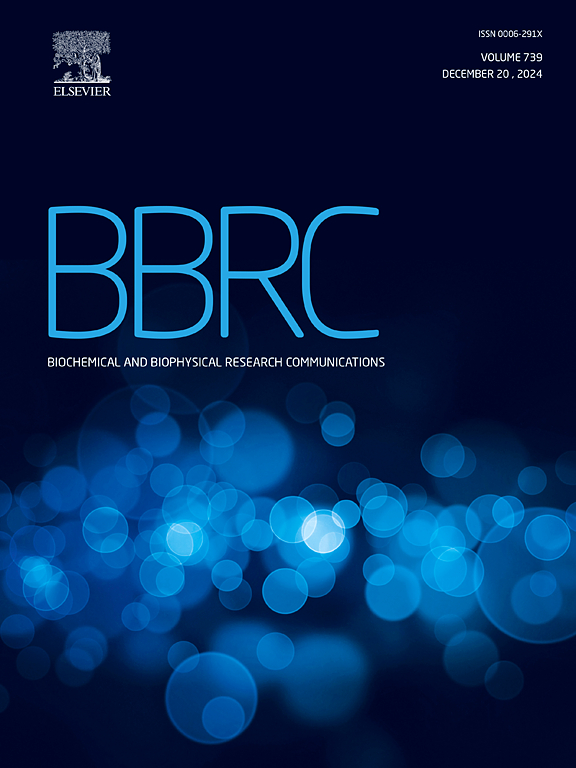Time-resolved fluorescence of ANS dye as a sensor of proteins LLPS
IF 2.5
3区 生物学
Q3 BIOCHEMISTRY & MOLECULAR BIOLOGY
Biochemical and biophysical research communications
Pub Date : 2025-01-01
DOI:10.1016/j.bbrc.2024.151164
引用次数: 0
Abstract
The explosive growth in the number of works addressing the phase separation of intrinsically disordered proteins has driven both the development of new approaches and the optimization of existing methods for biomolecular condensate visualization. In this work, we studied the potential use of the fluorescent dye ANS as a sensor for liquid-liquid phase separation (LLPS), focusing on visualizing condensates formed by the stress-granules scaffold protein G3BP1. Using fluorescence lifetime imaging microscopy (FLIM), we demonstrated that ANS can accumulate in RNA-induced G3BP1 condensates in aqueous solutions, but not in G3BP1 condensates formed under macromolecular crowding conditions in highly concentrated PEG solutions. We showed that the experimentally determined limiting fluorescence anisotropy (r0'), which characterizes the amplitude of high-frequency intramolecular mobility of ANS in aqueous solutions containing RNA-induced G3BP1 condensates, is half the value observed for ANS in aqueous G3BP1 solutions. Our results demonstrate the feasibility of using time-resolved fluorescence spectroscopy and microscopy of ANS for detecting LLPS of intrinsically disordered proteins in aqueous solutions.
ANS染料作为LLPS蛋白传感器的时间分辨荧光。
研究内在无序蛋白质相分离的工作数量的爆炸式增长,推动了生物分子凝聚可视化新方法的发展和现有方法的优化。在这项工作中,我们研究了荧光染料ANS作为液-液相分离(LLPS)传感器的潜在用途,重点研究了由应力颗粒支架蛋白G3BP1形成的冷凝物的可视化。利用荧光寿命成像显微镜(FLIM),我们发现ANS可以在水溶液中rna诱导的G3BP1凝聚物中积累,但在高浓度PEG溶液中大分子拥挤条件下形成的G3BP1凝聚物中不积累。我们发现,实验确定的极限荧光各向异性(r0′)是表征ANS在含有rna诱导的G3BP1凝聚物的水溶液中高频分子内迁移幅度的值,是在G3BP1水溶液中观察到的值的一半。我们的结果证明了使用时间分辨荧光光谱和ANS显微镜检测水溶液中内在无序蛋白的LLPS的可行性。
本文章由计算机程序翻译,如有差异,请以英文原文为准。
求助全文
约1分钟内获得全文
求助全文
来源期刊
CiteScore
6.10
自引率
0.00%
发文量
1400
审稿时长
14 days
期刊介绍:
Biochemical and Biophysical Research Communications is the premier international journal devoted to the very rapid dissemination of timely and significant experimental results in diverse fields of biological research. The development of the "Breakthroughs and Views" section brings the minireview format to the journal, and issues often contain collections of special interest manuscripts. BBRC is published weekly (52 issues/year).Research Areas now include: Biochemistry; biophysics; cell biology; developmental biology; immunology
; molecular biology; neurobiology; plant biology and proteomics

 求助内容:
求助内容: 应助结果提醒方式:
应助结果提醒方式:


